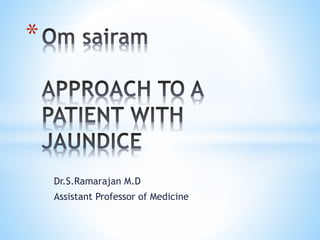
Approach to a patient with jaundice
- 1. Dr.S.Ramarajan M.D Assistant Professor of Medicine *
- 2. * *Whether the hyperbilirubinemia is predominantly conjugated or unconjugated in nature. *Whether other biochemical tests are abnormal.
- 5. * Bilirubin in serum Hepatic/biliary removal of the pigment Production of bilirubin
- 6. *
- 8. * *Hemolytic process resulting in overproduction of bilirubin (HEMOLYTIC DISORDERS & INEFFECTIVE ERYTHROPOIESIS). *Impaired uptake /conjugation of bilirubin(DRUG EFFECT or GENETIC DISORDERS)
- 9. *
- 10. 1.Indirect hyperbilirubinemia 1. Hemolytic disorders 1. Inherited 1. Spherocytosis, elliptocytosis 2. Glucose-6-phosphate dehydrogenase and pyruvate kinase deficiencies 3. Sickle cell anemia 2. Acquired 1. Microangiopathic hemolytic anemias 2. Paroxysmal nocturnal hemoglobinuria 3. Spur cell anemia 4. Immune hemolysis 5. Parasitic infections 1. Malaria 2. Babesiosis 2. Ineffective erythropoiesis 1. Cobalamin, folate, thalassemia, and severe iron deficiencies 3. Drugs 1. Rifampicin, probenecid, ribavirin 4. Inherited conditions 1. Crigler-Najjar types I and II 2. Gilbert's syndrome CAUSES OF ISOLATED HYPERBILIRUBINEMIA
- 11. * • Complete absence of UDPGT activity • Reduced UDPGT activity CRIGGLER NAJAR syndrome type 1& 2 • Reduced UDPGT activity • Bilirubin 6mg/dL GILBERT syndrome
- 15. *
- 16. * *Direct hyperbilirubinemia *Inherited conditions *Dubin-Johnson syndrome *Rotor's syndrome
- 17. * • Mutation in gene for multiple drug resistance protein 2 Dubin johnson syndrome • Problem with hepatic storage of bilirubin Rotor syndrome
- 19. * *Drugs. * H/o transfusions, intravenous and intranasal drug use ,tattoos and sexual activity. *H/o recent travel. *H/o exposure to people with jaundice . *H/o Exposure to contaminated foods. *H/o Alcohol consumption.
- 20. *H/o myalgia , arthralgia ,rash. *Anorexia , weight loss *Abdominal pain *Fever *Pruritus *Changes in urine and stool colour.
- 21. * *Arthralgia and myalgia precluding jaundice- HEPATITIS(viral or drug related). *Jaundice associated with sudden onset of severe RUQ pain and chills – CHOLEDOCHOLITHIASIS AND ASCENDING CHOLANGITIS.
- 22. * *Temporal and Proximal muscle wasting – cirrhosis or pancreatic cancer. *Features of Chronic liver disease. *VIRCHOW’S NODE. *Sister Mary Joseph’s nodule. *ELEVATED JVP, ASCITES, RIGHT PLEURAL EFFUSION - CONGESTION
- 23. * *Enlarged left lobe of liver – cirrhosis. *Nodular liver or abdominal mass- malignancy. *Enlarged tender liver- hepatitis viral or alcoholic , acutely congested liver. *Murphy’s sign- cholecystitis. *Ascites + jaundice – cirrhosis or malignancy.
- 24. * *Patients with hepatocellular process- aminotransferases elevation disproportionate to ALP. *Patients with a cholestatic process have disproportionate elevation of ALP compared to aminotransferases.
- 26. *SERUM ALBUMIN – A low serum albumin suggests a chronic process such as cirrhosis or cancer. *PROTHROMBIN TIME – elevated PT indicates either vitamin K deficiency due to prolonged jaundice or malabsorption or significant hepatocellular dysfunction.
- 27. Viral hepatitis • Hepatitis A, B, C, D, and E • Epstein-Barr virus • Cytomegalovirus • Herpes simplex Alcohol Drug toxicity • Predictable, dose-dependent, (e.g., acetaminophen) • Unpredictable, idiosyncratic, (e.g., isoniazid) Environmental toxins • Vinyl chloride • Jamaica bush tea—pyrrolizidine alkaloids • Kava Kava • Wild mushrooms—Amanita phalloides or A. verna Wilson's disease Autoimmune hepatitis HEPATOCELLULAR CONDITIONS THAT MAY PRODUCE JAUNDICE
- 28. * Viral hepatitis Alcohol DRUGS TOXINS Wilson’s disease/Autoimmune Hepatitis
- 29. * *Patients with alcoholic hepatitis will have AST :ALT ratio of 2:1 *AST rarely exceeds 300 U/L. *Patients with hepatitis due to viral or toxin-related will have Aminotransferases > 500 U/L.
- 30. * *IgM HAV. *Hbs Ag. *IgM anti Hbc. *HCV RNA. *Tests for EBV,CMV. *Wilson’s disease do Serum Ceruloplasmin level. *Autoimmune hepatitis – ANA and specific immunoglobulins.
- 31. * *Intrahepatic *Extrahepatic *Do an USG that will detect the presence of biliary dilatation. *Biliary dilatation + = extrahepatic cholestasis *Biliary dilatation - = intrahepatic cholestasis
- 32. * • Intrahepatic cholestasis • Primary biliary cirrhosis • Primary sclerosing cholangitis Extra hepatic cholestasis • Benign • Malignant
- 33. 1.Intrahepatic 1. Viral hepatitis 1.Fibrosing cholestatic hepatitis—hepatitis B and C 2.Hepatitis A, Epstein-Barr virus, cytomegalovirus 2. Alcoholic hepatitis 3. Drug toxicity 1.Pure cholestasis—anabolic and contraceptive steroids 2.Cholestatic hepatitis—chlorpromazine, erythromycin estolate 3.Chronic cholestasis—chlorpromazine and prochlorperazine 4. Primary biliary cirrhosis 5. Primary sclerosing cholangitis 6. Vanishing bile duct syndrome 1.Chronic rejection of liver transplants 2.Sarcoidosis 3.Drugs CHOLESTATIC CONDITIONS THAT MAY PRODUCE JAUNDICE
- 34. 1.Inherited 1.Progressive familial intrahepatic cholestasis 2.Benign recurrent cholestasis 2.Cholestasis of pregnancy 3.Total parenteral nutrition 4.Nonhepatobiliary sepsis 5.Benign postoperative cholestasis 6.Paraneoplastic syndrome 7.Venoocclusive disease 8.Graft-versus-host disease 9.Infiltrative disease 1.TB 2.Lymphoma 3.Amyloidosis
- 35. * *Hepatitis B, Hepatitis C can cause a cholestatic hepatitis. *Hepatitis A , CMV, EBV, alcoholic hepatitis can also produce cholestatic picture. *Primary biliary cirrhosis –Antimitochondrial antibody. *Primary sclerosing cholangitis- multiple strictures of bile ducts with dilatation proximal to strictures.
- 36. * *Distal CBD is an area that is difficult to be visualized by USG. *CT scan . *MRCP (Magnetic resonance cholangiography). *ERCP(Endoscopic Retrograde Cholangio Pancreatography).
- 37. * *Benign and malignant cause. *Malignant causes include Pancreatic, Gall bladder , Ampullary and cholangiocarcinoma.
- 38. *Extrahepatic *Malignant *Cholangiocarcinoma *Pancreatic cancer *Gallbladder cancer *Ampullary cancer *Malignant involvement of the porta hepatis lymph nodes *Benign *Choledocholithiasis *Postoperative biliary structures *Primary sclerosing cholangitis *Chronic pancreatitis *AIDS cholangiopathy *Mirizzi syndrome *Parasitic disease (ascariasis)
- 39. * SUMMARY
- 42. *
- 43. * Dubin Johnson syndrome Rotor syndrome
- 44. * Viral hepatitis Alcohol DRUGS TOXINS Wilson’s disease/Autoimmune Hepatitis
- 45. * • Intrahepatic cholestasis • Primary biliary cirrhosis • Primary sclerosing cholangitis Extra hepatic cholestasis • Benign • Malignant
- 46. * *Total bilirubin- 6.3mg/dl. *Direct bilirubin – 3.9 mg/dl. *Indirect bilirubin- 2.4 mg/dl.
- 47. *SGOT – 292 U/L. *SGPT – 542 U/L. *ALP – 60 U/L.
- 48. *TOTAL PROTEIN – 5.6 gm/dl. *Albumin – 3.7 gm/dl. *Globulin 1.9 gm/dl. *A/G ratio 1.9:1
